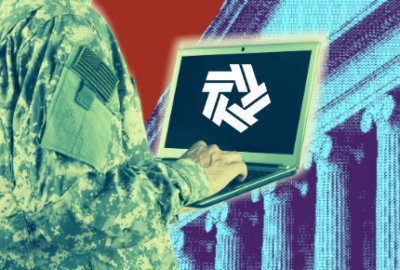

Hubbard Radio Washington DC, LLC. All rights reserved. This website is not intended for users located within the European Economic Area.
The Defense Department's data strategy released just a few weeks ago says improving data management will help it fight and win wars.
Best listening experience is on Chrome, Firefox or Safari. Subscribe to Federal Drive’s daily audio interviews on Apple Podcasts or PodcastOne.
The Defense Department’s data strategy released just a few weeks ago says improving data management will help it fight and win wars. It says artificial intelligence will become an important component of data-fueled digital modernization. For an assessment, the CEO of data analysis company Govini, Tara Murphy Dougherty joined Federal Drive with Tom Temin.
Interview transcript:
Tom Temin: Tara, good to have you back.
Tara Murphy Dougherty: Thanks, Tom. It’s great to be here.
Tom Temin: So give us from your standpoint, as someone who analyzes DoD data itself, what does this data strategy really say? What are they actually trying to do here?
Tara Murphy Dougherty: Sure. So as a company that’s purpose built for national security problems related to data and leveraging the use of AI and machine learning to solve these problems, we do track defense data issues very closely. So I was thrilled to see the data strategy be released in early October. That alone is a significant achievement. But overall, it’s really strong on content, too, which is not something you can take for granted with these government documents sometimes.
Tom Temin: Well, these types of government documents seem to fall into two categories, I call them “16 pages and under,” “200 pages and greater,” and this one falls into the smaller category. So it’s kind of a high level view of what they plan to do. There’s a few fresh acronyms. But is there more beyond that, that we’re just not seeing in terms of detail of execution?
Tara Murphy Dougherty: There is Tom, there’s a lot packed into this relatively short document. And the most important takeaway from the DoD data strategy is that it establishes data as a strategic resource for the department. And that was exactly the right place to start. The second key takeaway is that for the first time, the department is looking holistically at the use of data across the operational battlefield applications of data and use of data in support of joint all-domain operations, as well as senior leader decision support and business analytics, laying that groundwork and taking that holistic approach. Those are really important elements of the first ever data strategy. Like I said, it was the right place to start. And now the question will be can it execute the blueprint that it provides alongside those core elements, which is fairly ambitious.
Tom Temin: Yes, under Section 4 there are seven goals and enabling objectives: Making data visible, making it accessible, understandable, linked, trustworthy, interoperable, and secure. They even have a acronym VAULTIS, for all of that. And that’s a big bite that they’ve taken here. And it seems like the only sensible way to try to carry it out is application by application, otherwise they’re, to use the old term, boiling the ocean.
Tara Murphy Dougherty: Boiling The ocean is exactly what I thought as well. But as a framework, the comprehensive nature of it works really nicely. And I believe that was the goal. Also, it wouldn’t be DoD if they didn’t put an acronym on it. So there’s that. The key to achieving these goals is not only going to be execution and how this strategy turns into plans, it’s going to be the answer to the question of whether the department and the leadership is prepared to resource these activities. We may be facing budget cuts in upcoming years, we may not that’s still an open question. But as budgets start to constrict, if they head in that direction, this will be a tough area to argue for additional resources and growing investments for modernization. Hopefully, the strategy is effective in cementing the need for those resources and making the case for the importance of this for the department, which it very, very much is. And the key to that importance is really how the strategy talks about the use of data and the role of data in artificial intelligence, which we know is going to play a significant role in the future of warfare. And data is core to effective AI.
Tom Temin: We’re speaking with Tara Murphy Dougherty, she is the CEO of Govini. And the DoD does have a dedicated channel of spending on artificial intelligence. There’s a program office for this. And then you have each of the armed services that have their own artificial intelligence requirements they can see clearly, and perhaps program offices working there, plus all of the other components. So integration, governance, all of those pieces would seem to be also equally important here.
Tara Murphy Dougherty: Exactly. And one of the additional recent changes from DoD is the establishment of the first ever chief data officer that happened a few years ago. And there’s a new chief data officer in place – David Spirk, coming from [U.S. Special Operations Command] – very accomplished, defense professional. He has really taken the perspective that DoD needs to think about data, not just in a strategic way, but in a streamlined way, where he as the person accountable and responsible for data operations within DoD can have visibility into the full spectrum of not just data activities and data systems, but also personnel who are working on data, whether that’s as data scientists or people supporting the elements of the data enterprise in DoD. That is an ambitious undertaking but if he can pull it off, will be really effective to having a sense of where those resources need to go. And where the department is getting the best return on its investment in data capabilities.
Tom Temin: Is it necessary for them to inventory the data that the department has? I think the reference is to the larger massive flows of data that are generated? Or is it better to approach it from the application standpoint, by saying, here’s what we want to do. Now let’s go find the data that’s out there that we need for this, and maybe back into some kind of a catalog?
Tara Murphy Dougherty: It’s probably best to start with how data is being used. This is an area where the Joint Artificial Intelligence Center for DoD has done a really good job of highlighting the most important areas where DoD needs to be using its data and starting there in terms of setting standards and improving data hygiene. And the not always glamorous, but actually very important aspects of data work that make it effective. You know, you mentioned earlier, the funding – the dedicated funding line for DoD, and there’s a lot of funding in the department that goes into AI efforts. They’re not always centralized. They’re not always coordinated. This was part of the original premise of creating the JAIC, as it’s known. And yet we see, on one hand, the department saying that artificial intelligence is a key priority for DoD, and an absolutely important aspect of being an effective competitor in our great power competition that we’re facing primarily with China. And then on the other hand, you look at the budget numbers and funding for the joint Artificial Intelligence Center is flat over the next five years. So we are going to have to get a handle on not just what the strategy is, not just what the plans are to execute it, but ensure that what goes out the door from a funding perspective actually lines up with that strategy.
Tom Temin: Well, just to make an absurd analogy, which maybe shows that this needs to be very diffuse, you could say that, yes, artificial intelligence is important to competitive advantage. So is the ability to shoot straight and hit the target. But there’s not one department of shooting straight. It’s something that is distributed over every member that’s on the tooth end of the military. So maybe they have to diffuse this artificial intelligence, skill and data knowledge to the edges?
Tara Murphy Dougherty: That’s exactly right. And that is another achievement of the DoD data strategy is the fact that it really took on and took on purposefully, the cultural and workforce aspects of this. I was surprised, frankly, that there was so much attention given to the talent and workforce side of bringing data into DoD and making the department an increasingly data-driven organization. And yet it was exactly right to do so. So then the question will be how much does the department decide it needs to internalize and internally resource or create both from a talent perspective in terms of developing technical skills for its workforce. And how much does it want to rely on the private sector? And that’s an area where the department had a really solid model for private sector collaboration in the Cold War. And we certainly over the past 10 to 15 years have seen a significant growth in efforts from the Department of Defense to work with innovative new technology companies, and to reach what we’re calling the national security innovation base, rather than the traditional defense industrial base. But there’s still a long way to go there. And I’m not convinced that the department yet has really figured out what its new model is, particularly in the data and software and other technology sectors.
Tom Temin: Sounds like they need a couple of good wins they can point to to kind of give everyone an example of what’s possible.
Tara Murphy Dougherty: That would go a long way, particularly on the heels of this data strategy. As I mentioned, just getting it out the door is a big win for DoD. Now it will need to take steps to start to implement it and that will cement these principles, these goals these essential capabilities and indeed the way ahead.
Tom Temin: Tara Murphy Dougherty is the CEO of Govini. Thanks so much.
Tara Murphy Dougherty: Thank you, Tom.
Tom Temin: We’ll post this interview along with a link to the DoD data strategy at FederalNewsNetwork.com/FederalDrive, subscribe to the Federal Drive at Podcastone or wherever you get your podcasts.
Copyright © 2024 Federal News Network. All rights reserved. This website is not intended for users located within the European Economic Area.
Tom Temin is host of the Federal Drive and has been providing insight on federal technology and management issues for more than 30 years.
Follow @tteminWFED


